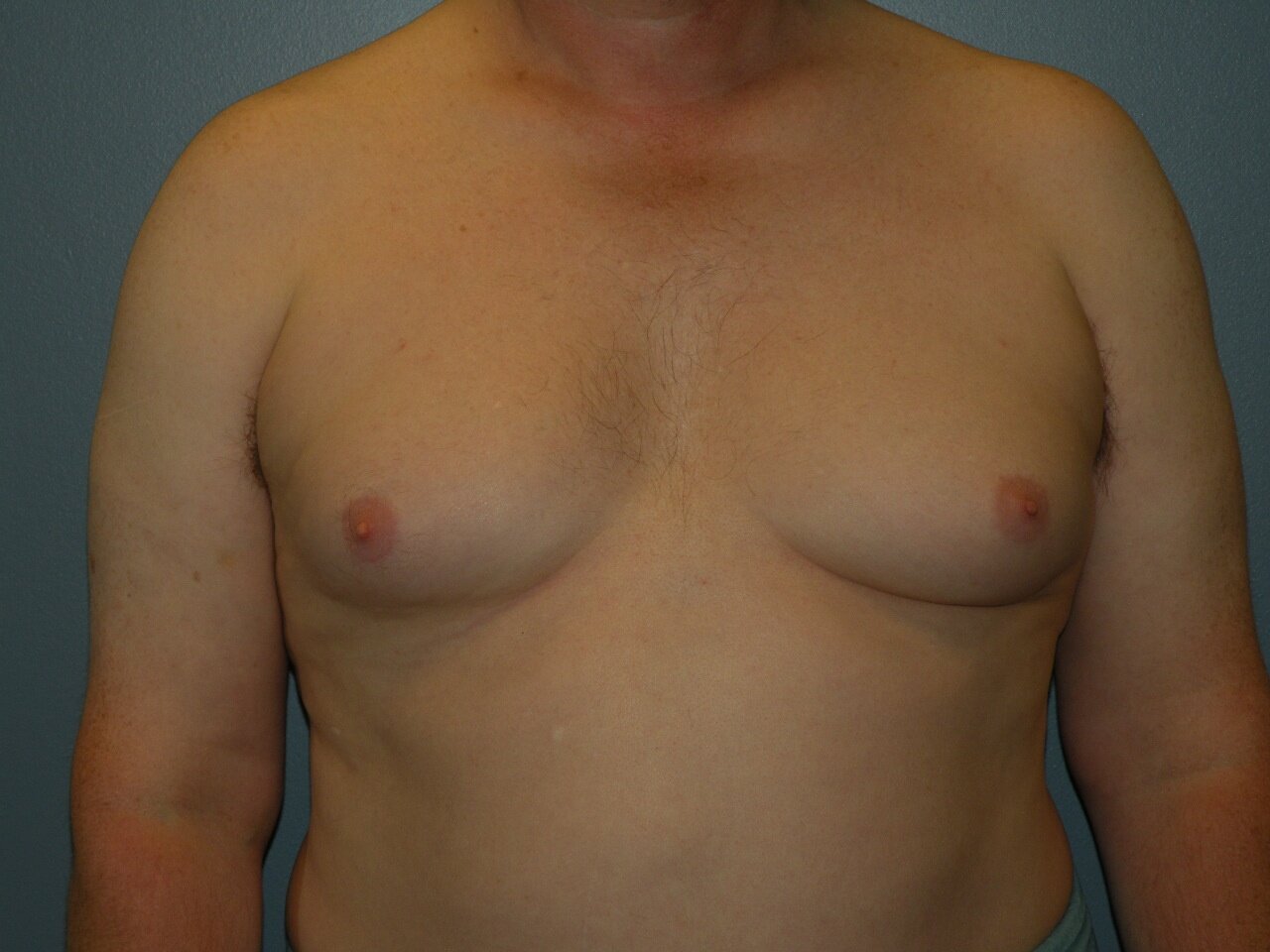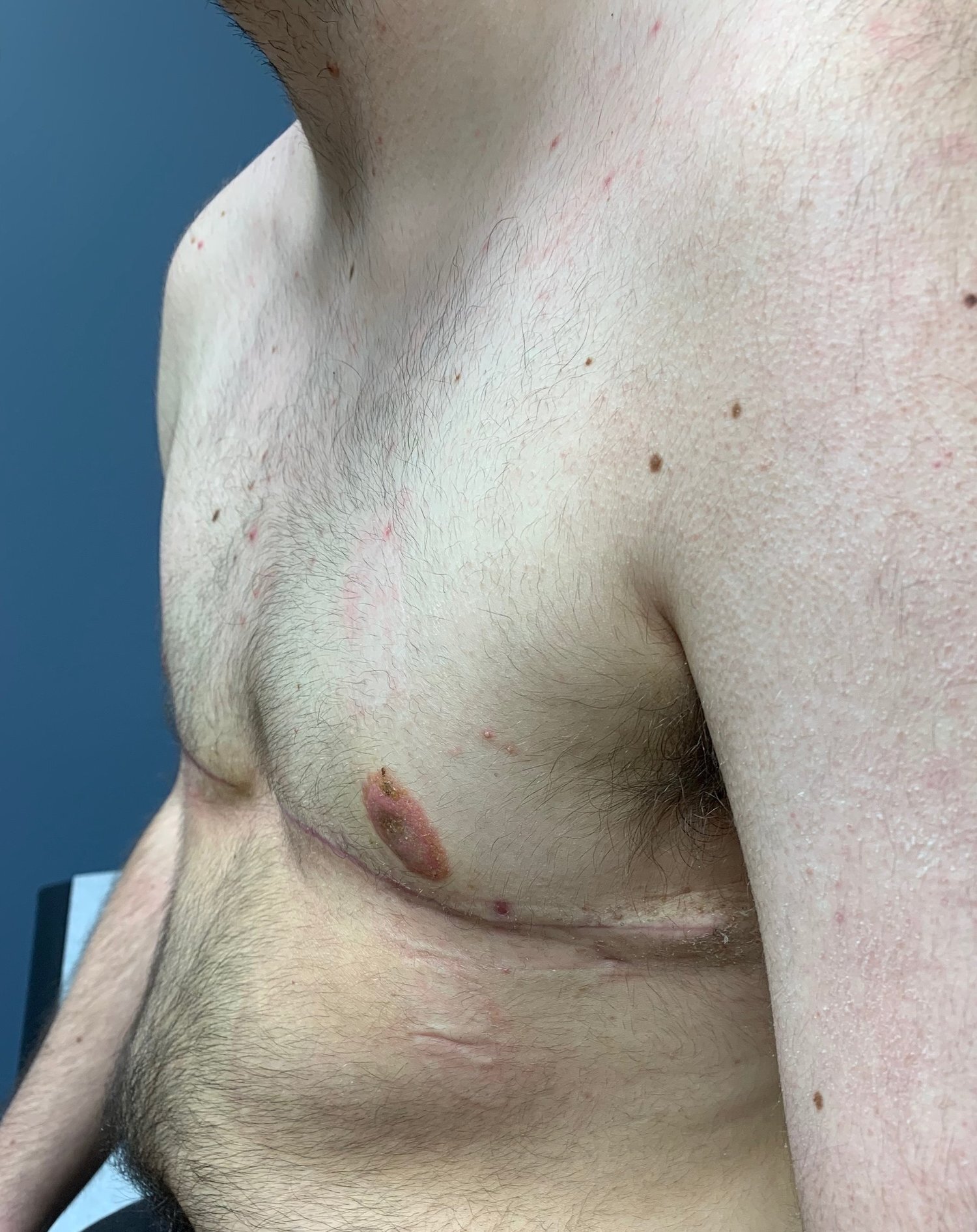
Gynecomastia
*DISCLAIMER: THIS SITE CONTAINS GRAPHIC & SURGICAL IMAGES THAT MAY BE DISTURBING TO SOME VIEWERS.
THIS SITE IS INTENDED FOR INDIVIDUALS OVER THE AGE OF 18.
**None of the images on this site have been enhanced or photoshopped.
*Tap a patient image to enlarge & view the full series of pre and post-operative images.
Patient I - 30 year old Post Operative Saline Breast Augmentation


Before & After Photos
Navigate to The Operation for additional images and information specific to Grade IA, Grade IIA and Grade IIB Gynecomastia.
Before the Surgery:
+ What is Gynecomastia?
Gynecomastia is male breast development. The size of the enlargement may vary from a very small amount of breast tissue that grows behind the nipple areola, to a full sized breast which mimics a large female breast.
+ What causes Gynecomastia?
The vast majority of Gynecomastia has no definite cause (idiopathic). The most common time for this development is during the peri pubertal development stage in a male. The majority of this developmental Gynecomastia resolves by the age of 19 years. For a small percentage of males, it does not resolve and may become problematic producing a cosmetic disability. Gynecomastia may run in families, which predisposes the male children to develop Gynecomastia, if the father of the male child also has Gynecomastia. Those males predisposed, who are overweight, are more likely to develop Gynecomastia.
There are certain medication and drugs that predispose a male to develop Gynecomastia. There are many, but the more common drugs are, Androgenic Steroids, used by recreational and professional athletes, certain diuretics, hair preserving products, and chronic use of cannabis. Men being treated medically for prostate cancer with estrogen based medication are also predisposed.
There are certain medical conditions that can produce Gynecomastia. A full medical workup, for men with Gynecomastia, by a Family Physician is recommended.
+ Can I get rid of Gynecomastia without surgery?
Developmental peri pubertal Gynecomastia will spontaneously subside, with the passage of time, in a majority of males. Weight loss in an overweight male may assist in reducing the breast size. Avoidance of medication or recreational drugs, which predispose a male to Gynecomastia, is advisable. Weight lifting to increase the size of the chest muscles (pectoralis) may help camouflage minor Gynecomastia, to a limited extent.
There is no evidence that Gynecomastia predisposes a man to breast cancer.
+ When is surgery advised?
A peri pubertal male, with rapid and large breast development, which produces a significant cosmetic deformity, with psychological and social impact, may be a candidate for the surgical treatment of the Gynecomastia before the age of 19 years.
After puberty, if the Gynecomastia did not resolve, and the non-surgical options have not reduced or eliminated the Gynecomastia, surgical treatment may be a consideration.
The Operation:
+ What are the surgical options?
The surgical techniques used to treat Gynecomastia, depends on how large the male breast is, as well as, its shape:
See https://www.meadowlarksurgicalcosmetic.com under Gynecomastia.
Grade I:
This is a firm, often painful disc of breast tissue directly under the nipple areola. This can be treated surgically by removing this breast tissue, through an incision from the 3 o’clock to 9 o’clock, in the lower half of the areola, at the junction of the dark areola and the normal skin. This can be done under Local (freezing) with, or without, sedation or General Anesthesia (the patient is completely asleep).
Grade IIA:
In addition to the breast tissue, there is a substantial amount of adipose tissue, mixed with the breast tissue, that creates a moderately large breast mound. The nipple areola are in the correct position on the chest wall, and there is no excess redundant skin. This can be treated surgically, by removing this breast tissue through an incision from the 3 o’clock to 9 o’clock, in the lower half of the areola, at the junction of the dark areola and the normal skin.
Liposuction is used at the same time, to reduce the adipose tissue, and feather the edges of the resection margin, to produce a flat male chest. This is done under General Anaesthesia.
+ What are the surgical options? (continued)
Grade IIB:
This Gynecomastia takes the form of a full female breast, with excess breast and adipose tissue, skin redundancy (excess skin), and an abnormally low nipple areola, similar to a breast ptosis seen in a female breast. See FAQ Breast Lift
This can be surgically treated by the removal of breast and adipose tissue, removal of excess skin, reducing the size, and, relocating the nipple areola.
+ Are there before and after pictures?
Yes. Every patient that Dr. Giuffre operates on, for cosmetic reasons, will have a preoperative photograph taken. At the 6 week check up with Dr. Giuffre, his patients are given an 8 x 10 preoperative photograph.
Post Operative photos are also taken in some instances.
+ Do I have to go to sleep (General Anesthesia) to have a Gynecomastia surgery?
A General Anesthesia is required for large Gynecomastia cases, (Grade IIA, and, IIB). Smaller Gynecomastia cases, (Grade I), could be done under Local Anaesthesia, with or without sedation.
+ How long does the operation last?
Approximately an hour to an hour and one half.
+ Where is the surgery performed?
Dr. Giuffre uses a private surgical suite, adjacent to his Meadowlark Health Centre Office (#176) for his cosmetic procedures.
+ Where is the incision made?
The incision is made around the lower half of the nipple areolar complex, for both Grade I, and Grade IIA cases.
For Grade IIB cases, there is an incision around the circumference of the areola, and in the breast crease, where it meets the chest wall.
+ Will there be a scar?
Yes. Any incision in the skin, regardless of where on the body, will heal with a scar. The scar will mature, (the scar colour goes from red, to pink, to white, and the scar then softens and becomes pliable) which can take 1-2 years. Medical paper tape placed directly over the incision, and changed weekly for 3 months, will help speed up the process of scar maturation. Tap show more below to see visual.
+ Will I have stitches?
Yes. They are under the skin and absorb, (disappear by themselves) therefore, no sutures are removed.
+ Is the procedure painful?
Before waking from the surgery, Dr. Giuffre will inject a long acting local anesthetic, into the breast area, to decrease any immediate breast discomfort from the surgery. When the freezing wears off, you will require postoperative analgesic medication, (pain killers) for up to a week. The discomfort typically subsides after the first two days following the surgery.
Patients taking prescription pain killers, should not drive a car or operate machinery, or sign significant documents, while taking this medication.
+ Do I go home the same day as Surgery?
Yes. You will have to arrange a ride, and aftercare, with a responsible adult. You are NOT permitted to leave unaccompanied, or in a taxi, if you have had a General Anaesthetic or Sedation.
+ I live out of town. Should I stay overnight?
If your driving distance from Edmonton exceeds 90 minutes, you should make arrangements to stay overnight in Edmonton. The surgical centre does not have an overnight care facility. You will be seen, the following day, for dressing removal and assessment by Dr Giuffre and his staff.
+ Can I contact my surgeon throughout the day or night, following my surgery, should I have a concern?
Yes. Dr. Giuffre provides his home phone number to his cosmetic patients, in case there are any patient concerns.
In the rare instance that a patient requires hospitalization, Dr. Giuffre has admitting privileges to all of the major hospitals in Edmonton.
+ When do I see my surgeon after surgery?
You will be seen the day, following surgery, by Dr. Giuffre and/or his nursing staff, and again, within the week following surgery by Dr. Giuffre. Further follow up arrangements will be made at that time. Your dressing will be removed.
+ When can I shower?
A shower is okay after the first dressing change, which is usually done the next day, after surgery.
It is okay to get the incision wet in the shower, however, Dr. Giuffre recommends that you AVOID a hot tub, bath, swimming pools, as well as, lake and ocean swimming, for 6 weeks following surgery.
+ In what position can I sleep?
You may sleep in whichever position is most comfortable.
+ What should I do to minimize scarring?
Vitamin E oil, and Bio Oil, are not proven to positively impact scar healing. Dr. Giuffre recommends medical paper tape, placed on the incision, changed weekly by the patient, for a period of 3 months.
+ How long should I plan to be off of work?
The typical time off work is one week. If your work is extremely strenuous, and involved heavy lifting, the time off of work will be longer.
+ How long am I off sports and my workouts?
No sports or strenuous activity is permitted for 4-6 weeks. Patients are to avoid strenuous activity that increases their heart rate and blood pressure. This could produce bleeding inside the breast pocket. The rule of thumb is, if you are sweating from the activity, you are over doing it and placing yourself at risk.
The Risks:
+ What are the risks of doing Breast Gynecomastia surgery?
With any surgery, there are surgical and anesthetic risks. Aside from the rare risks of an anesthetic event, som of the general and specific surgical risks for this procedure would include:
- scarring
- infection
- sensation change to the breast or nipple
- nipple necrosis (rare)
- discomfort
- time off work and exercise
- contour abnormality
- asymmetry
- bleeding (hematoma)
- risk of recurrence
- cost for surgery
*Please note that his is NOT a complete list.
During the consultation with the patient, Dr. Giuffre will outline and explain each of the risks in detail.
The Followup:
+ How often do I need to come back for a checkup after the surgery?
Postoperative visits include a 24 hour visit, a 1 week visit, and a 6 week visit. If there are any patient concerns, Dr. Giuffre provides his home phone number for patient’s direct access. After the 6 week visit, if there are any future requests for an appointment, they are made directly with Dr. Giuffre’s office, and an expedited visit is arranged.
+ I no longer have access to my original surgeon. What can I do?
For cosmetic or reconstructive concerns, patients are invited to contact Dr. Giuffre's office (780-428-7737) for an appointment. He does not require a referral and there is no charge for the consultation.
+ Does the public health care system cover any of the costs of a Breast Gynecomastia? What about my Private Insurance?
Alberta Health Services will cover breast reconstruction for patients who have been treated for prostate cancer, and who require estrogen medication. A side effect of estrogen is breast enlargement.
Alberta Health Services will NOT cover breast surgery for aesthetic reasons, even with a family doctor referral, or a psychiatric or psychological referral.
Private Insurance may cover the cost. Please contact your insurance company for written confirmation of coverage.
+ Can I use the costs of Gynecomastia Surgery as a tax deduction?
CRA eliminated the use of cosmetic surgery as a tax deduction a number of years ago. Unless you can demonstrate that the procedure is a promotional cost for your business, it is not tax deductible.
If there is a medical need confirmed by your doctor, you may be able to deduct the cost with a letter from your doctor, outlining the medical need/necessity for the procedure, along with the receipt for the surgery.
+ Can I finance the costs of the surgery? How do I do this?
Dr. Giuffre does not provide in house financing for cosmetic procedures. There are a number of companies across Canada that will finance cosmetic surgery, not much different than car financing or mortgages. Please refer to the links provided on the Home Page for this information.
Dr. Giuffre has no financial or business relationship or affiliation with any of these companies.
+ If something goes wrong, do I have to repay for the operation?
You do not have to pay for the treatment of an immediate complication. In the unusual event that there is a problem with your original surgery, such as a gross breast deformity, or, significant asymmetry, you do not have to pay for the correction. Correction of subtle differences in the breast and chest wall, resulting in minor asymmetries, may result in additional charges for a correction.
If you have a recurrence of the Gynecomastia, due to the use of medication, recreational drugs, or weight gain, the surgery would result in additional charges.
+ How much does it cost?
The cost of cosmetic surgery is covered entirely by the patient. The one fee would include, the cost of the anesthetist (who provides the General Anesthetic), the rental of the operating room and equipment, the rental of the recovery room and equipment, the staff, including the nurses and administration staff, and the surgical fee. The cost will vary, depending on the duration of the procedure, the type of anaesthesia (local, local and sedation, or general anaesthesia) and the quality and sophistication of the surgical facility where the surgery is done.
The fees will be discussed at the time of consultation with Dr. Giuffre. There is no obligation to proceed with surgery following the consultation. The patient is referred to our web sites, and is invited back for a second consultation if need be. Our office will endeavour to expedite a surgical procedure to accommodate both business and family obligations. All fees are receipted.
+ What about having cosmetic surgery in another country, where it is less expensive?
There is a current trend to have surgery out of your country, where the surgery may be cheaper. We call this “Tourist Surgery”.
There are a number of additional risks, including:
The surgical skill, experience, licensing, and education of an unknown surgeon.
Canada has very strict rules and requirements to be a licensed Plastic Surgeon (FRCS(C)) in our country. In Canada, your Plastic Surgeon has completed an undergraduate degree (4 years), an MD degree (4 years), a Fellowship Degree in Plastic Surgery (5 years) and often, a post Fellowship (1-2 years).
A “friend” is not a good reference, nor is glitzy advertising.
The safely, sterility, and equipment quality, including anaesthesia machines in the hospital or private surgical suite; this may lead to increased risk of infection, as well as, increased anaesthetic risks.
Post operative care is limited to the time you spend in their country. If you have a complication, to see your original surgeon, you will have to fly back or see a new surgeon in your own country.
If you have an unsatisfactory result, you will have to fly back to see your original surgeon or find a new local Plastic Surgeon. The cost of the repair may exceed what you originally paid, and the final result, fixing a mistake, is often not as good as it could have been, had the surgery been done correctly the first time.
After accounting for the accumulated costs of the air travel, hotel, surgery and post operative care, the perceived cost savings may not be significant.
If you have a severe, life threatening complication, Alberta Health Care will cover the medical costs for your care. Correcting the reconstructive problem as a result of the complication would be the patient's financial responsibility.
“Life is full of choices; your character reflects those choices.”














































